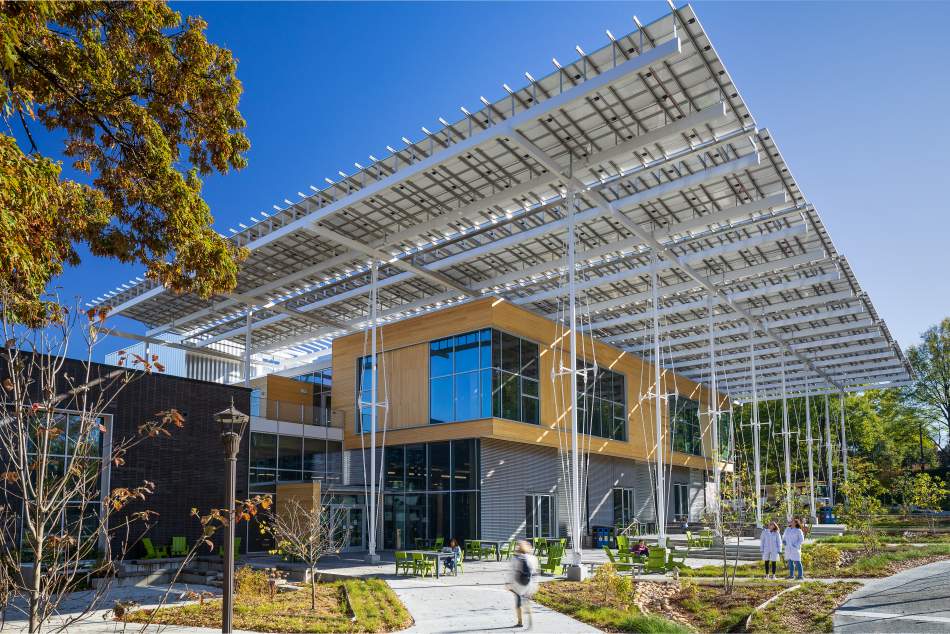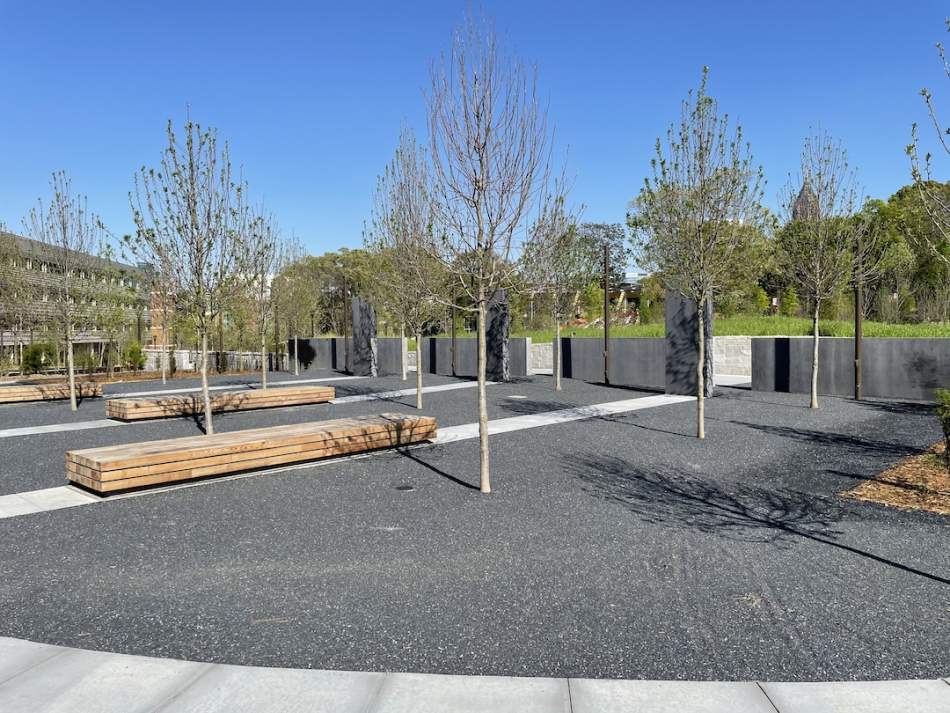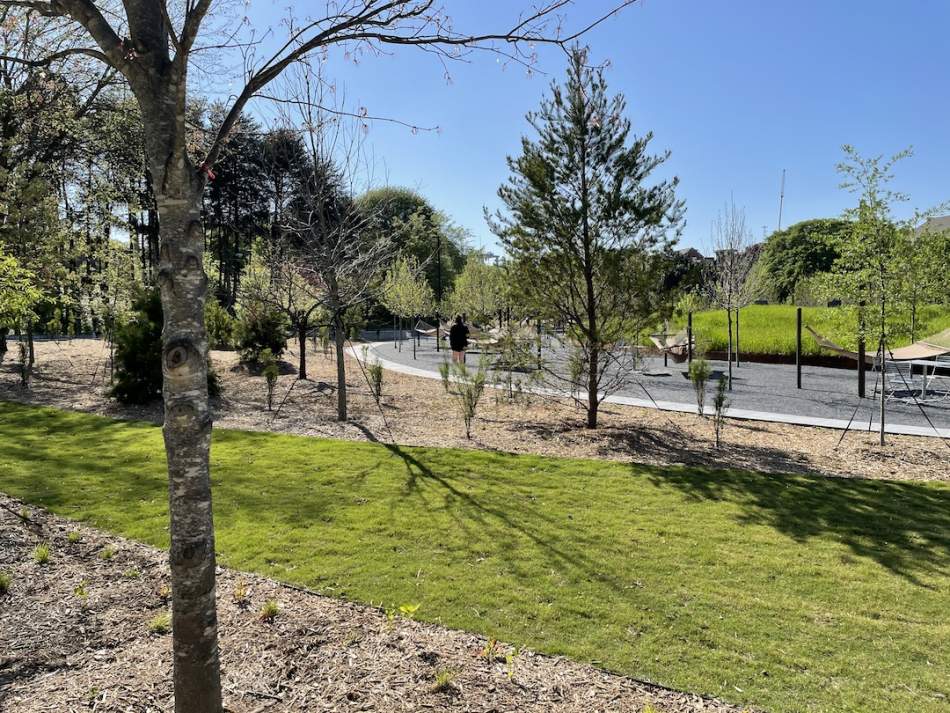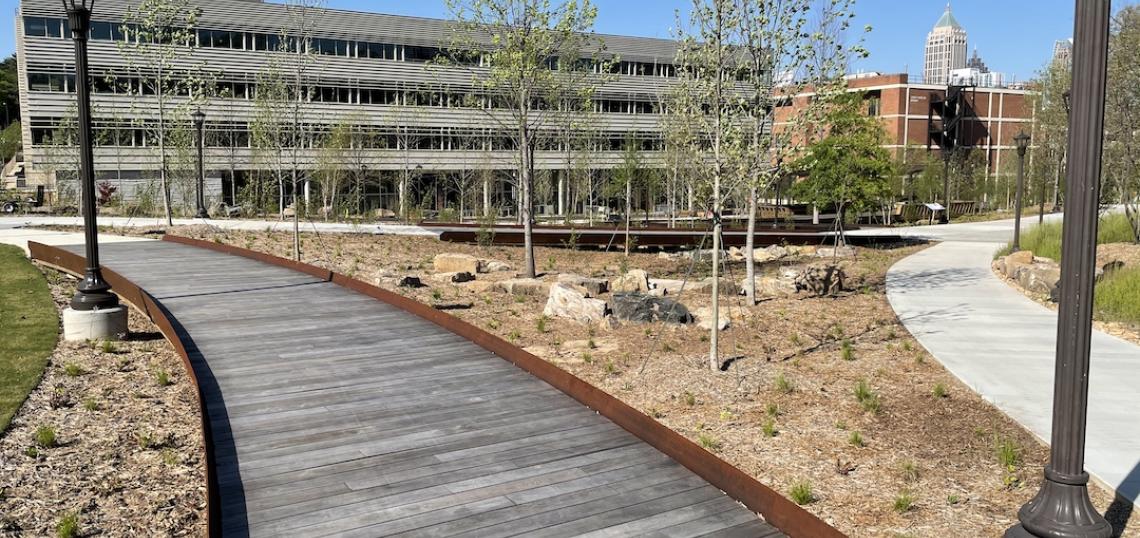At a glance, the largest standalone landscape architecture project in Georgia Tech’s history seems like a beacon of natural peace and forward-thinking green design. The antithesis, that is, of racial strife and threats of mob violence.
But on Monday, following a ribbon-cutting ceremony, the new Georgia Tech EcoCommons will officially open to the public as an ecological teaching tool that also daylights the ugly racial history of a site most recently dominated by police buildings and sprawling parking lots.
Designed by Nelson Byrd Woltz Landscape Architecture, the EcoCommons span 7 acres from Hemphill Avenue to the self-sustaining Kendeda Building, the “living” structure that’s widely considered the Southeast’s greenest building.
 Topped with solar arrays, the Kendeda Living Building at the park's eastern rim.Photo by Greg Willett, courtesy of Georgia Tech/Kendeda Fund
Topped with solar arrays, the Kendeda Living Building at the park's eastern rim.Photo by Greg Willett, courtesy of Georgia Tech/Kendeda Fund
While researching the site, the architecture team learned of its complex history prior to its most recent uses. A theme of social justice, they knew, would have to be front-and-center in the design.
This is where Lester Maddox’s Pickrick Diner once stood. Maddox, a staunch segregationist, would later become Georgia governor with Ku Klux Klan support.
The diner made history on July 3, 1964—one day after the landmark Civil Rights Act passed.
That’s when three Black students from the Atlanta Interdenominational Theological Seminary— George Willis Jr., Albert Lee Dunn, and Woodrow T. Wilson—asked to be seated at Maddox’s all-white diner, to exercise their new rights, and all hell broke loose.
“As tensions mounted, the owner and a mob threatened violence, [and] the students departed peaceably,” according to a summary provided by the architecture firm. “While not unique to the region, the events at the site brought the issues of racism and segregation into clear focus, [leading] to the first federal lawsuit under the 1964 civil rights law Willis v. Pickrick Restaurant [that] upheld the new civil rights law.”
Maddox, as Atlanta historians know, chose to close his diner rather than integrate it.
 Courtesy of Nelson Byrd Woltz Landscape Architecture/Georgia Tech
Courtesy of Nelson Byrd Woltz Landscape Architecture/Georgia Tech
Now, when visitors approach the EcoCommons from Hemphill Avenue, a wall guides them to the former restaurant site, through a grove of black gum and tupelo, to three solid pillars meant to “recall the stand that the three students … took against injustice.” That facet also references the Three Pioneers sculpture, in nearby Harrison Square, commemorating the first Black students who in 1961 desegregated Georgia Tech.
The symbolism continues with three longleaf pines—the only such trees in the new park—that stand near steel walls tracing the exact foundation of Maddox’s former restaurant.
“The design team committed to honoring the bravery of these students, hoping to provide a space for the community to confront intolerance and allow for contemplation, conversation, and healing,” according to Nelson Byrd Woltz reps.
 Hammocks and laptop-ready tables installed within the EcoCommons. Courtesy of Nelson Byrd Woltz Landscape Architecture/Georgia Tech
Hammocks and laptop-ready tables installed within the EcoCommons. Courtesy of Nelson Byrd Woltz Landscape Architecture/Georgia Tech
Elsewhere, the EcoCommons feature a learning deck for research and classes, hammocks and seating for relaxation, and a contemplative grove. Eventually, the site will be 75 percent shaded by native Georgia trees.
The greenspace is also designed to capture 50 percent of all rainfall in huge cisterns used to irrigate the site, sparing the city’s sewer system millions of gallons of runoff water, per the design team.
Eventually, the EcoCommons Project is expected to span 80 acres across campus, tracing the region’s natural, pre-urbanization stream paths and paying homage to ecologies and human history—warts and all—that could have been erased.
• Now installed, John Portman's 'last sculpture masterpiece' is rather amazing (Urbanize Atlanta)






